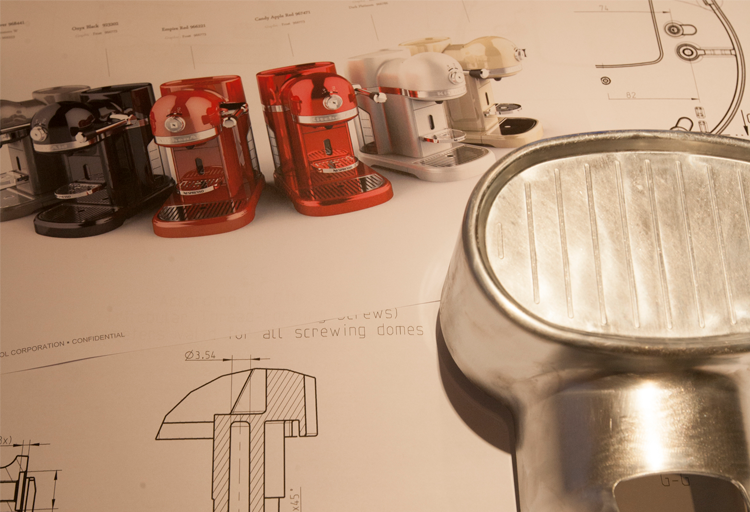As winner of numerous international awards, Bruschi Spa is known for its innovative approach in design and technology. We are glad to share our insights and experiences with the industry members.
Zinc alloys: an advantageous choice for manufacturers of small household appliances

Zinc alloys are an excellent choice for creating and manufacturing appliance components. This blog post will explain why zinc alloys are widely used in this sector, highlighting their aesthetic, functional, environmental, and economic advantages.
Aesthetic advantages
Zinc alloys offer numerous aesthetic advantages, including the main one, an excellent tactile feeling which conveys a sensation of robustness and solidity to the object and is also pleasing to the eye due to its technical and technological qualities.
In addition, the design of the zinc alloy components is customizable, both through painting which offers a wide range of colors and finishes to adapt to the desired design, and through numerous galvanic treatments, such as, e.g., nickel or chrome plating, to obtain a shiny and wear-resistant appearance over time.
Functional advantages
The functions of zinc alloys in household appliances, on the other hand, are manifold. The zinc die-casting process offers a unique result in the field of alloys: providing a finished product at the first stage of its processing. That automatically translates into significant savings in terms of costs and production times.
Furthermore, the superior fluidity of zinc alloys allows for thinner thicknesses to be created (unlike other materials, especially plastics), reducing the costs of the raw materials used without renouncing the rigidity requirements of the product, which are fundamental for obtaining equally functional but with a small footprint. In addition, the dimensional stability, resistance to vibrations, and impact resistance are further advantages offered by zinc alloys, making them ideal for internal and external parts of small appliances.
The ductility of zinc alloys is another fundamental aspect of this material and brings great advantages for creating household appliances. This property, in fact, makes it possible to use riveting as an alternative fastening method to screws; reducing the machining costs required for threading and the assembly times needed for tightening the screws; no less important are the aesthetic and cost results for assemblies with rivets, which unlike screws can be hidden from view and translate into economic efficiency since fewer components are needed to create the same finished piece.
Finally, among the functional qualities of zinc alloys, we can also mention the excellent level of shielding from magnetic fields of this material, in fact preventing the electronic and electrical components from interfering with each other, compromising the product's performance.
Environmental benefits
From an environmental point of view, zinc alloys represent an ecological, eco-sustainable, and ideal choice for a circular economy. Zinc alloy parts are totally recyclable. They can be recovered and reused countless times, helping to reduce the environmental impact of plastic waste and other non-recyclable materials. They require less energy for their transformation, which makes their use more sustainable from an energy point of view.
Economic advantages
The use of zinc alloys, unlike other die-casting alloys, undoubtedly has economic benefits in production. The transformation from solid to liquid state of zinc alloys for die-casting requires lower temperatures and therefore consumes much less energy than, for example, aluminum alloys. That also translates into a considerably longer life of the moulds. With the same use, a zinc die-casting mold can also be used for up to a million cycles without deterioration, allowing for considerable savings in production costs.
This aspect is particularly evident when considering the cost of the moulds for producing aluminum parts, which require more frequent replacements.
Practical examples
A significant example of the application of zinc alloys in small household appliances can be seen above all in the kitchen. Most manufacturers of quality household appliances use zinc or zamak alloy components to give their products solidity, stability, and aesthetic finishes.
For example, the external and internal housings of small appliances are often made of zinc alloy to guarantee a resistant and long-lasting structure. This approach is particularly evident in parts that require greater dimensional stability, such as bearing housings and internal supports of appliances.
Even the supports of electric motors are another example involving the use of zinc alloys. These components, found in many small appliances, can be made of zinc alloy instead of expensive reinforced plastics, offering a more environmentally and cost-effective solution.
Conclusions
Zinc alloys are confirmed as an excellent choice for small household appliances, offering numerous aesthetic, functional, environmental, and cost advantages. Their ability to be machined with precision, resistance to vibration and shock, total recyclability, and process cost savings make them ideal for meeting the needs of modern home appliances. Looking into our kitchens, we can appreciate how zinc alloys are successfully applied in the small household appliances sector. Choosing zinc alloys to produce parts and components means combining attractive design, reliable performance, environmental sustainability, and economic advantages.
